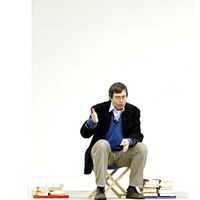Papers by Medhat Fam, Ed.D.
Progressive educators share the conviction that democracy means active participation by all citiz... more Progressive educators share the conviction that democracy means active participation by all citizens in social, political and economic decisions that will affect their lives. The education of engaged citizens, according to this perspective, involves two essential elements: (1) Respect for diversity, meaning that each individual should be recognized for his or her own abilities, interests, ideas, needs, and cultural identity, and (2) The development of critical, socially engaged intelligence, which enables individuals to understand and participate effectively in the affairs of their community in a collaborative effort to achieve a common good. Most progressive education programs have these qualities in common:

The Importance of School wide Professional Learning Community The school reform movement has emph... more The Importance of School wide Professional Learning Community The school reform movement has emphasized the professionalization of teachers' work. Teachers also need collegial resources for support and reenergizing. Educational networks or other professional organizations beyond the school may provide teachers with some forms of technical and collegial support. Discipline-based reform projects, such as those that formulate curriculum standards, can also become the basis for teacher commitment and interaction. But professional learning community offers the more inclusive support of a whole school: An entire faculty comes together around meaningful, shared issues, irrespective of teachers' individual disciplines. School wide community does not devalue other forms of collective professional relationships, nor is it incompatible with the department structure or interdisciplinary teaming. But it does entail staff members' taking collective responsibility for collaborating to achieve a shared educational purpose for the school as a whole. Elements of Professional Learning Communities The following five elements appear to be critical to school professional learning communities: shared norms and values, focus on student learning, reflective practice, public practice, and collaboration. Shared Norms and Values Values central to teachers' work include their views about children and children's ability to learn, school priorities for the use of time and space, and the proper roles of parents, teachers, and administrators. Communities come into existence and thrive because of common values and ways of working together. How people treat one another, their social taboos, and the whys and hows of celebrations are manifestations of norms and values in action. Shared norms and values establish reciprocal expectations for professional learning community members. Developing consciousness about norms and values is central to the community-building process. Leaders at all levels of the school teach in two ways: by example and by articulated values and explicit norms for interaction. Focus on Student Learning Attentiveness to student learning is a core characteristic of schools in which professional learning community is strong. Professional learning communities focus on student learning as the " end " and on teaching as the " means ". In too many school teams and departments, professional sharing consists of little more than swapping activities and exchanging materials. " What is good work? " " Do all students have ample opportunities to learn important material? " " How can instruction be differentiated to meet the needs of diverse learners? " These are a few of the questions asked in schools with professional learning communities. Such conversations focus on the output of teaching, not on the input. To achieve the goal of cumulative effect, departments in secondary schools and teams in elementary and middle schools clarify among themselves the standards for quality student performance.
¨ Physiological needs-also known as biological needs. Consists of oxygen, food, water, constant b... more ¨ Physiological needs-also known as biological needs. Consists of oxygen, food, water, constant body temperature.

1. Teachers can use techniques learned from different theories to help the students succeed and t... more 1. Teachers can use techniques learned from different theories to help the students succeed and to reduce the stress that affects the students success and performance. When students feel they are important parts of the classroom, this will create a sense of community, self-regulation, self-efficacy and they will be motivated to succeed at school. 2. Bandera's social cognitive theory helps the students to succeed at school by promoting self-efficacy, self-esteem and self-regulation. 3. These three factors are: social or environmental factors, personal factors and behavioral factors. The environmental factors are the models, instructional strategies, and feedback. 4. Modeling is very important in Bandera's theory. Students observe the teacher. So, if the teachers instruct in an inviting, not threatening manner, this will motivate the students to learn and succeed. Remember, sometimes we can't control other people's behavior but we can control ourselves. 5. Bandura identify parent expectation of student achievement as one of the most dominant factors related to student achievement. Children tend to perform as their parents expect. Parent Involvement. Four conditions necessary for effective modeling to occur • Attention: the person must first pay attention to the model. • Retention: the observer must be able to remember the behavior that has been observed. One way of increasing this is using the technique of rehearsal. • Motor reproduction: the third condition is the ability to replicate the behavior that the model has just demonstrated. • Motivation: the final condition for modeling to occur is motivation; learners must want to demonstrate what they have learned. 6. Students often learn a great deal simply by observing other people. 7. Describing the consequences of behavior is can effectively increase the appropriate behaviors and decrease inappropriate ones. This can involve discussing with learners about the rewards and consequences of various behaviors. 8. Describing the consequences of behavior can effectively increase the appropriate behaviors and decrease inappropriate ones. Discussing with learners about the rewards and consequences of various behaviors.
Albert Bandura (1925-) is the founder of Social Learning Theory (SLT) which he renamed Social Cog... more Albert Bandura (1925-) is the founder of Social Learning Theory (SLT) which he renamed Social Cognitive Theory (SCT) The Theory attempts to understand the process that is involved in explaining how we learn from each other. SCT focuses on learning that occurs by direct experience—observing, imitating, and modeling. Learning, according to Bandura, " is the acquisition of verbal and visual codes of behavior that may or may not later be performed " Modeling is a key component to SCT Modeling = Observing behavior
Caine and Caine (1991) developed twelve principles that apply what we know about the function of ... more Caine and Caine (1991) developed twelve principles that apply what we know about the function of the brain to teaching and learning.

Jean Piaget was employed at the Binet Institute in the 1920s, where his job was to develop French... more Jean Piaget was employed at the Binet Institute in the 1920s, where his job was to develop French versions of questions on English intelligence tests. He became intrigued with the reasons children gave for their wrong answers on the questions that required logical thinking. Over the next fifty years, this curiosity led to the development of his theory of "genetic epistemology". Piaget's theory differs from others we have studied in several ways: • It is concerned with children, rather than all learners. • It focuses on development, rather than learning per se, so it does not address learning of information or specific behaviors. • It proposes discrete stages of development, marked by qualitative differences, rather than a gradual increase in number and complexity of behaviors, concepts, ideas, etc. The goal of the theory is to explain the mechanisms and processes by which the infant, and then the child, develops into an individual who can reason and think using hypotheses. To Piaget, cognitive development was a progressive reorganization of mental processes as a result of maturation and experience. Children construct an understanding of the world around them, then experience discrepancies between what they already know and what they discover in their environment. There are three basic components to Piaget's theory: • Types of knowledge (physical, logical-mathematical, and social-arbitrary) • Stages of development (sensorimotor, preoperational, concrete operational, formal operational) • Processes that enable the transition from one stage to another (assimilation, accommodation, and equilibration) Piaget's proposed stages of development An important thing to understand about these different levels is that they are qualitatively different. In other words, at each successive stage, it's not just a matter of doing something better, but of doing a different thing altogether. The function of cognitive growth is to produce increasingly powerful cognitive structures that permit the individual to act on the environment with greater flexibility. The sensorimotor period ranges from birth to about age 2. Infants learn mostly through trial and error learning. Children initially rely on reflexes, eventually modifying them to adapt to their world. Behaviors become goal directed, progressing from concrete to abstract goals. Objects and events can be mentally represented by the older child during this stage (sometimes called object
Basic assumption of behavioral theories is that maladaptive behaviors are learned and can be unle... more Basic assumption of behavioral theories is that maladaptive behaviors are learned and can be unlearned, and that new, more adaptive behaviors can be learned § It is a school of thinking in psychology that holds that conclusions about human development should be based on controlled observations of overt behavior rather than on speculation about unconscious motives or other unobservable phenomena; the philosophical underpinning of early theories of learning. § The Theories have been applied to a wide range of disorders and problems Experiments by behaviorists identify conditioning as a universal learning process. There are two different types of conditioning, each yielding a different behavioral pattern:

According to Mayer (2009), when WM capacity is exceeded as a result of cognitive overload learnin... more According to Mayer (2009), when WM capacity is exceeded as a result of cognitive overload learning is hindered. Mayer (2009) summarized the main goal of multimedia instruction in three steps in a model based on Sweller's cognitive load theory (1991): (1) managing essential processing of information, (2) reducing extraneous processing of information, and (3) fostering generative processing of information. Sweller (1991, 2006) envisioned three different types of cognitive load. ECL results from introducing new information to the learner. Extraneous factors promote cognitive load that is unrelated to the learning materials ICL derives from the brain actitivy expended to sort between necessary and irrelevant information received via an ECL. Intrinsic load results from managing essential processing of information. GCL refers to the information an instructor presents as vital to learning; that is, load generative from the processing of learning. Germaine load is essential to achieve meaningful learning. Sweller noted it was important to understand that learners may need to invest extra effort in processes that are directly relevant to learning as an example of schema construction. The GCL is the main contributor to learning (Sweller, 1991). Intrinsic Cognitive Load ICL results from the essential processing of information. According to foundational theorists Sweller, Van Merrienboer, and Paas (1998), ICL occurs during the learning of new information and the background or the expertise of the learner. The Expertise of the learner relative to the new information imposes IC. According to Sweller (2002), ICLis produced from element interactivity inside one's WM. Element interactivity refers to the simultaneous processing of new elements of information in WM as to achieve new schema construction. This process depends on the nature and complexity of the new material and the background of the learner. According to Kirschner (2002), a large ICL occurs when new and complex tasks are presented to a learner who does not have sufficient prior knowledge about the new material. Kirschner (2002) emphasized the role of the instructional designer to break material up into sub-components that can be processed separately in the beginning and recombined later on. Extraneous Cognitive Load Sweller (2006) defined ECL as unnecessary load on the WM as a result of wrong instructional techniques that direct students to engage in activities or seek information not related to schema construction. An ECL refers to the way information or activities are presented to a learner. Because learners have limited cognitive resources, the presence of the extraneous and intrinsic loads will reduce the cognitive processing available for necessary to meet the germane load (Sweller, 2006). Germane Cognitive Load GCL is necessary to the processing and construction of schemas from the WM. When the WM of the learner is sufficiently resourced without taxing capacities through use of the available intrinsic and the extraneous cognitive resources, learners may invest additional effort in processing the information that is related to the learning. This process will consequently increase the cognitive load but may reduce GCL which is essential for learning to take place (Sweller, 2006). GCL refers to the efforts made by the material designer or instructor to boost the construction of schemas in the WM (Artino, 2008). Cognitive load theory includes the concept of reducing of ECL and increasing GCL during the learning process. According to Sweller

According to Kanokpermpoon (2013), a learner's WM is filled and becomes unfocused when different ... more According to Kanokpermpoon (2013), a learner's WM is filled and becomes unfocused when different materials are presented at the same time. The simultaneous presentation of materials can increase ICL as a result of split-attention. Presenting two or more forms of the same information, such as reading text and a visual table, could increase cognitive load as a result of the redundancy effect. Both split-attention and the redundancy effect hinder the learning process and avoiding either allows more capacity in WM to process, especially in foreign language learning (Kanokpermpoon, 2013). The redundancy effect and the split attention effect have common characteristics, and both include multiple sources of information, such as, audio and visual materials. However, the difference is in the logical relations between the multiple sources of information. The redundancy effect refers to a case when the design of instruction or curriculum contains multiple sources of information that can be understood separately without the need of mental integration. The split-attention effect refers to multimedia instruction formats that require students to split their attention between multiple sources of information; thus, increasing the ECL due to the mental integration of the multiple sources of information (Sweller, et al., 2013).Pociask (2004) argued that meaningful learning occurs when the learner makes a connection between different kinds of presentations of the same information, such as using both audio and visual materials for the same information. According to Kalyuga (2011), the dual presentation of information increases the efficiency of WM and does not decrease cognitive load. The Modality Effect According to Reinwein (2011), the modality effect refers to learning via dual loops, such as auditory and visual materials, which are assumed to be processed by different subsystems in the WM. Clark and Mayer (2011) found that presenting audio text may help learners learn better rather than presenting the same text in written format. Sweller and Chandler (1991) stressed the modality principle in dealing with complex learning. Kanokpermpoon (2014) stated that learning foreign languages using dual loops helps to increase the cognitive capacities of learners. Watkins and Watkins (1980) found that spoken and written discourse assisted foreign language learners.

Worked Examples Theory as Related to Cognitive Load Theory Medhat Fam, Ed.D. Cognitive load theor... more Worked Examples Theory as Related to Cognitive Load Theory Medhat Fam, Ed.D. Cognitive load theory offers an explanation of the worked example effect. Sweller (2006) describes this mechanism of the human cognitive system. Cognitive load refers to the total load of mental activity imposed on the WM at one time. Sweller (2006) addressed the requirements for instructional design intended to suit learners' needs by describing the three different kinds of cognitive load that may affect learners: (a) An ECL refers to the design or the manner of introducing new information to the learner; (b) ICL refers to the burden on the WM placed by unnecessary or irrelevant information that the learner must address,; (c) The GCL refers to the target load the instructor uses to maximize learning.Sweller (2006) preferred that if both ICL and ECLs leave enough capacity in the WM, then learners may invest the effort in increasing the GCL that is relevant and important to learning. Schema construction of subject matter tasks is an example of investing relevant GCL (Sweller, 2006). In the same article (2006), Sweller discussed the worked example effect, noting it is " the best known and most widely studied of the cognitive load effects " (p. 165). A worked example is described as a step-by-step demonstration of how a learner performs a task or solves a problem. The aim of using the worked example is to reduce the load in the WM or the cognitive load, because the less loaded the WM is, the more efficient it is for learning new tasks. WM is the vehicle that enables humans to think creatively and solve problems. Worked example is an excellent method to use to build new and rich knowledge in the LTM. The worked example method is popular to learners because they often choose worked examples over verbal descriptions (Sweller, 2006). According to Sweller, worked examples are detailed problem solutions that contain learning characteristics. Worked Examples Theory refers to the techniques used to foster cognitive processing in the learner, such as providing the learner an example that includes a solution to a problem. In the field of foreign language teaching, the use of worked examples is typically demonstrated through a series of steps: (a) the introduction of the problem, (b) the presentation of how other similar problems might be solved, (c) presenting an expert's model of solving a similar problem, and (d) introducing step-by-step solutions including graphic representations of the problem. According to Clark and Mayer (2002), a worked example is defined as a step-by-step demonstration of how to perform a task or solve a problem. A worked example is typically a job aid, or natural ways to help to accomplish some task. Clark and Mayer (2002) offered four guidelines for their use by suggesting that teachers (a) replace some practice problems with worked examples; (b) apply good practice when using text, audio, and graphics in worked examples; (c) provide diverse, job-realistic worked examples to help build mental models and train learners to self-explain as they use worked examples; (d) instructional worked examples aim at enhancing the student's skills to develop problem schemata by offering the learner solutions of similar examples. Clark and Mayer (2002) determined an advantage of worked examples in that they help build new mental models without exerting a heavy cognitive load. Research shows that students who employed more principle-based self-explanations benefited more from worked examples than those who did not. These researchers have also shown that the worked examples strategy aims at helping students solve problems that can overload limited WM (Clark & Mayer, 2002). Schnotz and Kurschner (2007) placed much emphasis on the importance of optimizing germane load; cognitive load theory, however, deals with three different loads. Intrinsic load quality is








Uploads
Papers by Medhat Fam, Ed.D.